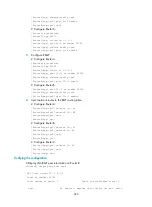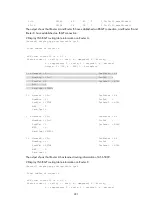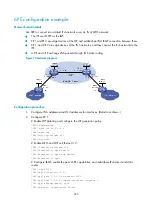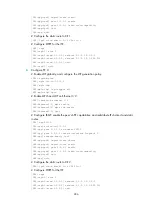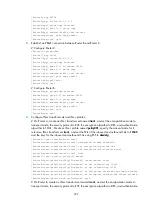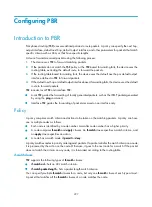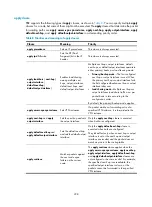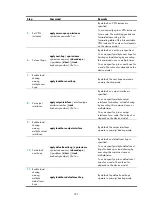
288
# Ping the IPv6 address 4::4 (loopback interface address) of CE 2 from CE 1. The ping operation
succeeds.
BFD for IPv6 BGP configuration example
Network requirements
As shown in
, configure OSPFv3 as the IGP in AS 200.
Establish two IBGP connections between Router A and Router C. When both paths are working, Router
C adopts the path Router A<—>Router B<—>Router C to exchange packets with network 1200::0/64.
Configure BFD over the path. Then if the path fails, BFD can quickly detect the failure and notify it to IPv6
BGP. Then the path Router A<—>Router D<—>Router C takes effect immediately.
Figure 75
Network diagram
Configuration procedure
1.
Configure IPv6 addresses for interfaces. (Details not shown.)
2.
Configure OSPFv3 so that Router A and Router C can reach each other. (Details not shown.)
3.
Configure IPv6 BGP on Router A:
# Establish two IBGP connections to Router C.
<RouterA> system-view
[RouterA] bgp 200
[RouterA-bgp] router-id 1.1.1.1
[RouterA-bgp] peer 2002::2 as-number 200
[RouterA-bgp] peer 3002::2 as-number 200
[RouterA-bgp] address-family ipv6
[RouterA-bgp-ipv6] peer 2002::2 enable
[RouterA-bgp-ipv6] peer 3002::2 enable
[RouterA-bgp-ipv6] quit
# Create IPv6 ACL 2000 to permit 1200::0/64 to pass.
[RouterA] acl ipv6 number 2000
[RouterA-acl6-basic-2000] rule permit source 1200:: 64
[RouterA-acl6-basic-2000] quit
# Create two route policies,
apply_med_50
and
apply_med_100
. Policy
apply_med_50
sets the
MED for route 1200::0/64 to 50. Policy
apply_med_100
sets that to 100.







